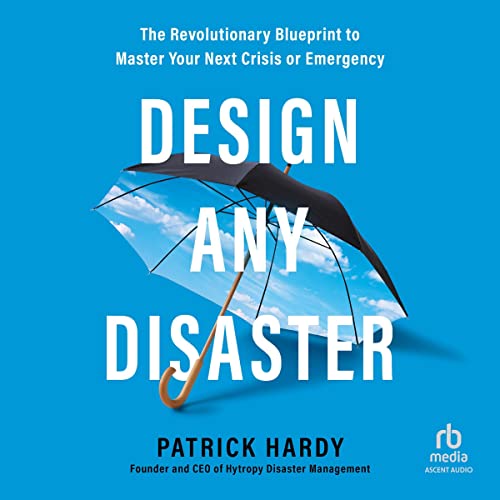The Disaster Preparedness Blueprint provides an accurate, concise plan for handling emergencies, ensuring safety and minimizing damages. Disasters can strike at any time without warning, leaving us vulnerable and unprepared.
Whether it’s natural disasters like earthquakes, floods, or hurricanes, or man-made disasters like fires or terrorist attacks, having a proper disaster preparedness blueprint is crucial for survival and resilience. This comprehensive guide outlines essential steps to take before, during, and after a disaster, including creating an emergency kit, developing evacuation plans, and staying informed.
By following these guidelines, individuals and communities can better protect themselves, their loved ones, and their properties. With a solid disaster preparedness blueprint in place, you can navigate through tough times with confidence and ensure a swift recovery in the aftermath of any emergency.
Building A Solid Foundation
Building a Solid FoundationWhen it comes to disaster preparedness, building a solid foundation is essential. It lays the groundwork for effectively handling any emergency or crisis that may arise. By taking proactive steps to assess potential hazards and creating an emergency plan, you can ensure that you are well-prepared for whatever comes your way.
Assessing Potential Hazards
Assessing potential hazards is the first step in disaster preparedness. By identifying and understanding the risks that exist in your environment, you can take the necessary precautions to minimize their impact. Consider the following:
- Identify natural disasters that are common in your area, such as earthquakes, hurricanes, or floods.
- Take note of any man-made hazards, such as chemical spills or power outages, that could occur.
- Consider the vulnerabilities of your home or workplace, including structural weaknesses or lack of safety equipment.
- Research historical data about past disasters in your region to gain insights into recurring threats.
By assessing these potential hazards, you can prioritize your preparation efforts and tailor your emergency plan to address specific risks.
Creating An Emergency Plan
An emergency plan is a crucial component of disaster preparedness. It provides a roadmap for how you and your loved ones will respond to an emergency situation. Here are some steps to help you create an effective emergency plan:
- Develop a communication strategy: Establish a designated meeting place and determine how you will stay connected during a crisis.
- Assemble an emergency kit: Include essential supplies such as food, water, first aid supplies, and important documents.
- Assign responsibilities: Identify specific tasks that each member of your household or team will be responsible for during an emergency.
- Practice emergency drills: Conduct regular drills to ensure everyone knows what to do and where to go in various scenarios.
Remember, an emergency plan is only effective if it is regularly reviewed and updated. As circumstances change, be sure to revise your plan accordingly and communicate any updates to everyone involved.

Credit: www.amazon.com
Essential Survival Skills
When it comes to disaster preparedness, having essential survival skills can mean the difference between life and death. Being equipped with First Aid and Medical Knowledge, Basic Survival Techniques, and the ability to Navigate and Orient in Disaster Areas will increase your chances of surviving and staying safe in any emergency situation.
First Aid And Medical Knowledge
In times of disaster, medical help may not be readily available. It’s crucial to have a basic understanding of first aid techniques and medical knowledge to provide immediate care to yourself and others. Here are some important skills to learn:
- Performing CPR and administering basic life support
- Stopping bleeding and dressing wounds
- Recognizing and treating shock
- Understanding and managing common injuries and illnesses
Gaining these skills can significantly enhance your ability to save lives and alleviate suffering in critical situations.
Basic Survival Techniques
In the face of a disaster, having basic survival skills will help you overcome challenges and sustain yourself until help arrives. Here are some essential techniques to master:
- Building a shelter using available resources
- Creating fire for warmth, cooking, and signaling for help
- Purifying water to ensure it’s safe for consumption
- Foraging for food in the wild
- Knowing how to signal for rescue
By developing these skills, you can increase your chances of survival and maintain a sense of security in adverse conditions.
Navigating And Orienting In Disaster Areas
During a disaster, familiar surroundings might become unrecognizable, making it crucial to know how to navigate and orient yourself. Here are some skills to help you find your way:
- Reading and using a compass
- Understanding topographic maps and landmarks
- Identifying natural directional cues, such as the sun and stars
- Estimating distances and calculating travel time
These skills will enable you to make informed decisions about your movements, stay on course, and find safety or assistance when needed.
Emergency Supplies And Equipment
Disasters can strike at any moment, leaving us vulnerable and in need of immediate assistance. That is why having the right emergency supplies and equipment is crucial in ensuring the safety and well-being of you and your loved ones. By being prepared with these essential items, you can navigate through a crisis with confidence and a sense of security.
Water And Food Storage
During a disaster, access to clean water and adequate food supplies may be limited. It is important to store enough water and non-perishable food to sustain you and your family for at least three days. You can use large water containers or jugs to store water, making sure to replace it every six months. Additionally, consider storing canned goods, dried fruits, energy bars, and other non-perishable items that require little to no preparation.
Emergency Shelter Options
Having a safe place to seek shelter during an emergency is vital. Depending on the situation, you may need to evacuate or hunker down at home. Make sure you have a plan in place for both scenarios. If evacuation is necessary, identify nearby shelters or the homes of friends and family where you can seek refuge. In case staying at home is the best option, ensure you have materials such as plastic sheeting, duct tape, and blankets to create a makeshift shelter to protect you from the elements.
Essential Tools And Equipment
To make it through a disaster, having the right tools and equipment can make all the difference. Some essential items to include in your disaster preparedness kit are:
- A flashlight with extra batteries to provide light when there is a power outage
- A battery-operated or hand-cranked radio to stay updated on emergency broadcasts
- A multi-purpose utility tool that includes pliers, a knife, a screwdriver, and other helpful tools
- A first aid kit with bandages, antiseptic wipes, medications, and other medical supplies
- A whistle to signal for help if you become trapped or lost
- Duct tape, plastic sheets, and garbage bags for temporary repairs and protection
These tools will assist you in navigating through the challenges that come with a disaster, ensuring your safety and aiding in any necessary repairs or first aid.

Credit: www.newyorker.com
Communication Strategies
In times of disaster, effective communication can be the key to survival. Being able to establish communication channels, utilize technology and social media, and create a family emergency communication plan are crucial aspects of disaster preparedness. By implementing these communication strategies, you can ensure that you and your loved ones stay connected and informed when it matters most.
Establishing Communication Channels
Establishing reliable communication channels is essential for disaster preparedness. Here are some tips to help you set up effective communication channels:
- Create a contact list of emergency contacts, including local authorities, family members, neighbors, and friends.
- Ensure that everyone in your household knows how to operate and use a basic landline phone, cell phone, and two-way radio.
- Identify a designated meeting point in case you are unable to communicate with your family members.
- Teach your children the importance of memorizing important contact information.
Utilizing Technology And Social Media
Technology and social media play a crucial role in disaster communication. Here’s how you can leverage these tools effectively:
- Stay informed by following emergency management and local government social media accounts.
- Download and familiarize yourself with relevant emergency apps, such as weather alerts or disaster tracking apps.
- Keep your cell phone charged and consider investing in an external power bank for extended power supply.
- Use social media platforms to share vital information, such as the status of your safety or updates on evacuation plans.
Creating A Family Emergency Communication Plan
A family emergency communication plan is crucial for staying connected during a disaster. Follow these steps to create your own:
- Designate an out-of-state contact person who can act as a central point of communication between family members.
- Establish a backup communication method in case traditional methods fail. This could be a designated email address or a messaging app.
- Discuss and practice your emergency communication plan with your family members to ensure everyone understands their roles and responsibilities.
- Decide on specific meeting places both inside and outside your immediate area in case you get separated.
Preparing For Specific Disasters
Disaster preparedness is crucial to ensure the safety and well-being of ourselves and our loved ones in times of crisis. While it’s impossible to anticipate every disaster scenario, having a blueprint in place can help mitigate the impact of these events. In this section, we will explore safety measures, survival tips, and evacuation strategies for specific disasters, such as earthquakes, hurricanes and floods, and wildfires.
Earthquakes: Safety Measures And Survival Tips
Earthquakes are sudden and often unpredictable natural disasters that can cause extensive damage and loss of life. To protect yourself during an earthquake, follow these safety measures:
- Identify safe spots in your home, such as under sturdy furniture or against interior walls away from windows.
- Bolt heavy furniture and appliances to the wall to prevent them from toppling over during the shaking.
- Create an emergency kit containing essentials like food, water, first aid supplies, and a flashlight.
- Practice the “Drop, Cover, and Hold On” technique during an earthquake. Drop to the ground, take cover under a sturdy piece of furniture, and hold on until the shaking stops.
- After the shaking ceases, be cautious of aftershocks and check for any injuries or structural damage.
Hurricanes And Floods: Preparing And Evacuation
Hurricanes and floods can wreak havoc on coastal areas, causing immense destruction and threatening lives. To prepare for these disasters and ensure your safety, consider the following:
- Create an emergency plan that includes evacuation routes, a designated meeting place, and contact information for emergency services.
- Secure your property by reinforcing doors and windows, and trimming trees and branches that could potentially damage your home.
- Stock up on necessary supplies, including non-perishable food, water, medications, and battery-powered devices.
- Stay informed about weather updates and heed evacuation orders from local authorities.
- If evacuation is necessary, pack essentials in a waterproof bag and leave early to avoid potential traffic congestion.
Wildfires: Prevention And Evacuation Strategies
Wildfires can rapidly spread and cause immense devastation to communities in their path. Take the following prevention and evacuation strategies into consideration to protect yourself and your property:
- Create a defensible space around your home by clearing dead vegetation and maintaining a safe zone.
- Install fire-resistant roofing materials and screens on vents to prevent embers from entering your home.
- Keep a survival kit ready, including goggles, N95 masks, and a portable radio.
- Pack important documents, valuables, and a change of clothes in case of evacuation.
- Stay aware of local wildfire warnings and instructions, and be prepared to evacuate if necessary.
Community Engagement And Support
Disaster preparedness is not a solo endeavor. In times of crisis, it is essential for communities to come together, support one another, and work collectively towards a common goal. A strong sense of community engagement and support can make a significant difference in the response and recovery efforts. In this blog post, we will explore two vital aspects of community engagement in disaster preparedness: preparing with neighbors and local communities, and volunteering in disaster relief organizations.
Preparing With Neighbors And Local Communities
When disaster strikes, your immediate neighbors and local communities can become your first line of defense. Collaborating with them beforehand can prevent panic and confusion during emergencies, ensuring a more efficient response. Here are some ways to prepare with your neighbors and local communities:
- Create a neighborhood emergency plan and encourage everyone to participate.
- Exchange contact information with your neighbors and establish a communication network.
- Identify vulnerable individuals in the neighborhood who may need additional assistance.
- Coordinate the sharing of resources such as food, water, and medical supplies.
- Organize drills and training sessions to practice emergency protocols.
By fostering a strong relationship with your neighbors and local communities, you can enhance your preparedness efforts and create a support system that will be invaluable during times of crisis.
Volunteering In Disaster Relief Organizations
Volunteering in disaster relief organizations is another effective way to contribute to community engagement and support. These organizations play a critical role in providing assistance and relief to those affected by disasters. Here are some reasons why you should consider volunteering:
- Gain valuable skills and knowledge in disaster response and recovery.
- Make a positive impact on the lives of those in need.
- Work alongside dedicated professionals and like-minded individuals.
- Build strong networks and connections within the disaster management community.
- Help raise awareness about disaster preparedness and encourage others to get involved.
Volunteering can be a fulfilling and rewarding experience, allowing you to make a meaningful difference in the lives of others while strengthening your own preparedness capabilities.
Maintaining Mental And Emotional Resilience
In times of disaster and crisis, it is essential to prioritize maintaining mental and emotional resilience. Coping with stress and trauma, implementing self-care strategies, and supporting others are all crucial aspects of ensuring our well-being during these challenging times.
Coping With Stress And Trauma
Stress and trauma are common during disasters, and it’s important to develop effective coping mechanisms to manage these emotions. Here are a few strategies to consider:
- Practice deep breathing exercises to help calm your mind and body.
- Engage in regular physical activity, such as walking or yoga, to release tension.
- Connect with loved ones and friends to discuss your feelings and experiences.
- Limit exposure to media coverage as constant news updates can increase anxiety levels.
Self-care Strategies
Taking care of yourself is crucial in times of crisis. Here are some self-care strategies you can implement:
| Adequate Sleep: | Ensure you get enough sleep to support your physical and emotional well-being. |
| Healthy Diet: | Eat nutritious meals that include fruits, vegetables, and whole grains to fuel your body. |
| Mindfulness: | Practice mindfulness techniques, such as meditation or journaling, to stay present and reduce stress. |
| Hobbies and Recreation: | Engage in activities you enjoy to relieve stress and bring a sense of normalcy to your life. |
Supporting Others In Times Of Crisis
In times of disaster, offering support to those around you can make a significant difference. Here are some ways you can assist others:
- Listen actively to their concerns and provide a compassionate ear.
- Offer practical help, such as providing food or assisting with household chores.
- Encourage them to seek professional help if needed and offer resources and information.
- Engage in activities together that promote relaxation and stress relief.
Maintaining mental and emotional resilience during a disaster is essential not only for our own well-being but also for supporting those around us. By coping with stress and trauma, implementing self-care strategies, and being there for others, we can navigate through the challenges and emerge stronger together.

Credit: gue.com
Frequently Asked Questions For Disaster Preparedness Blueprint
How Do I Create A Disaster Preparedness Plan?
Creating a disaster preparedness plan involves assessing risks, identifying evacuation routes, establishing communication protocols, stocking emergency supplies, and regularly practicing drills.
What Should Be Included In A Disaster Preparedness Kit?
A disaster preparedness kit should include essentials like food, water, medications, first aid supplies, flashlights, batteries, a radio, important documents, and a contact list.
How Often Should I Update My Disaster Preparedness Plan?
It is recommended to review and update your disaster preparedness plan at least once a year. Additionally, any significant changes in personal circumstances or the local environment should prompt an immediate update.
What Are The Most Common Natural Disasters To Prepare For?
Common natural disasters include hurricanes, earthquakes, floods, wildfires, and tornadoes. However, it is important to assess the specific risks in your area in order to tailor your disaster preparedness plan accordingly.
Conclusion
To ensure your safety during unforeseen events, implementing a disaster preparedness blueprint is essential. By following the steps outlined in this guide, you can equip yourself with the necessary tools and knowledge to effectively navigate through and withstand emergencies. Remember to regularly review and update your disaster plan to address any changes in circumstances.
With careful preparation and organization, you can confidently face any disaster and protect yourself and your loved ones. Stay prepared, stay safe.




